By the time I built my Caledonia yawl in 2003, I had done enough cruising to understand that I needed a boat that was not designed only for the usual functions while making way. Whether I sailed, rowed, motored, or even stayed put on any given day, I knew that every day I would need to eat and sleep. Two cruises up the Inside Passage made it clear that there were not always places to camp and even if there were, the inevitability of biting bugs and the chance of biting bears kept spending nights ashore out of the picture. I redesigned the yawl’s interior to include accommodations for cooking, eating, and sleeping.
That made life aboard much more comfortable, but I hadn’t given enough thought to another certain daily occurrence, using the toilet. I remedied that oversight with my next cruiser and built a place for a small porta-potti. Aside from the convenience it provides, it minimizes dependence on shore facilities and frees me from the less convenient system of wrap-it-up-and-pack-it-out I had practiced when I was camp-cruising by kayak.
The Dometic 972 is the first porta-potti I bought. (I later bought a second for my son to use on his boat.) It is 12-1/2″ tall, 14-1/2″ wide, and 16-1/2″ from front to back. Empty, it weighs 11.9 lbs. Its upper half has a 2.3-gallon freshwater tank for flushing, and is rated for up to 26 flushes.
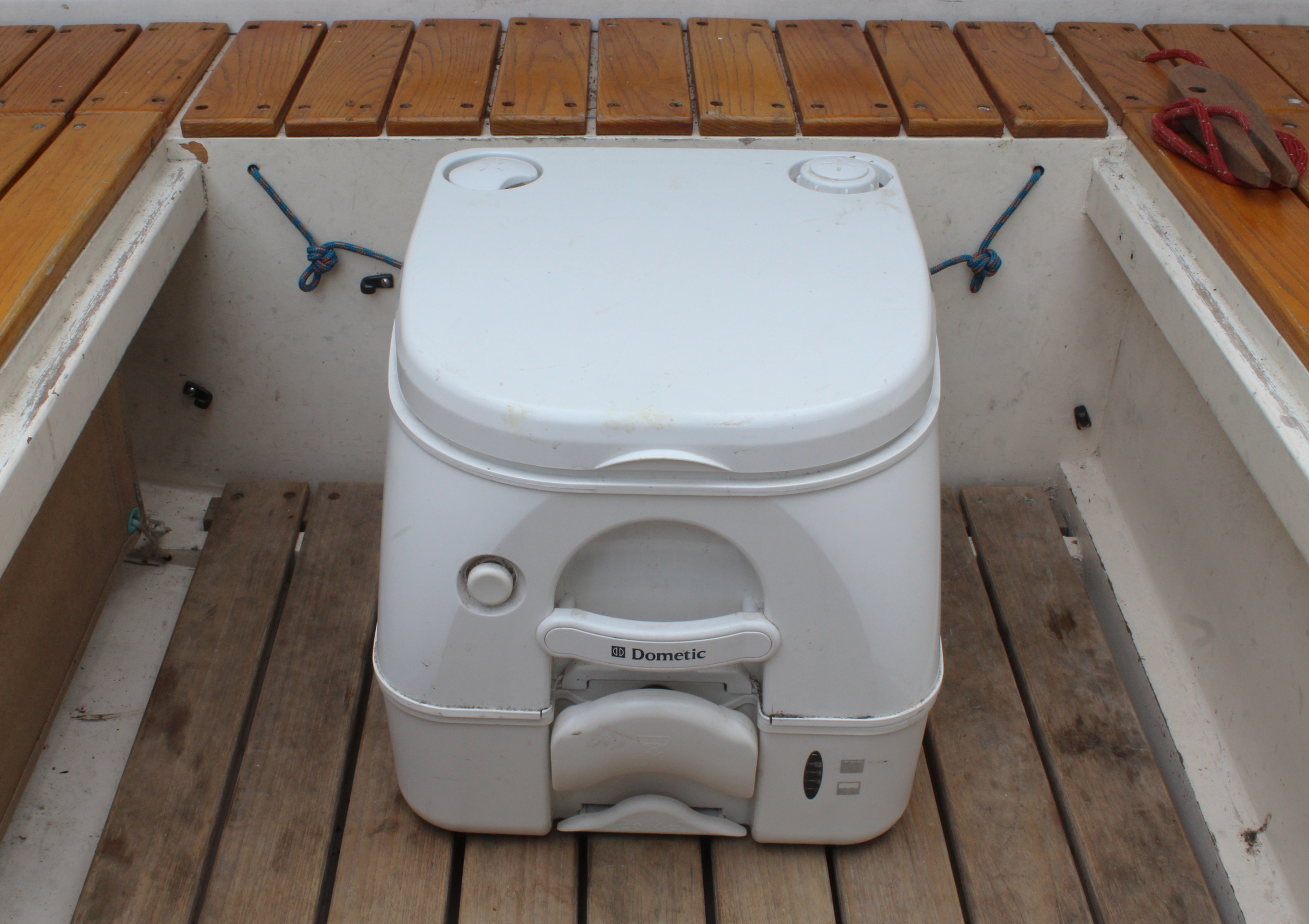 Photographs by the author
Photographs by the authorThe Dometic 135 has a push button (upper left) for the pressurized flush, and a gauge (lower right} to indicate the level in the holding tank.

Made of ABS plastic, the Dometic is the heavier of the two toilets and is more rigid.
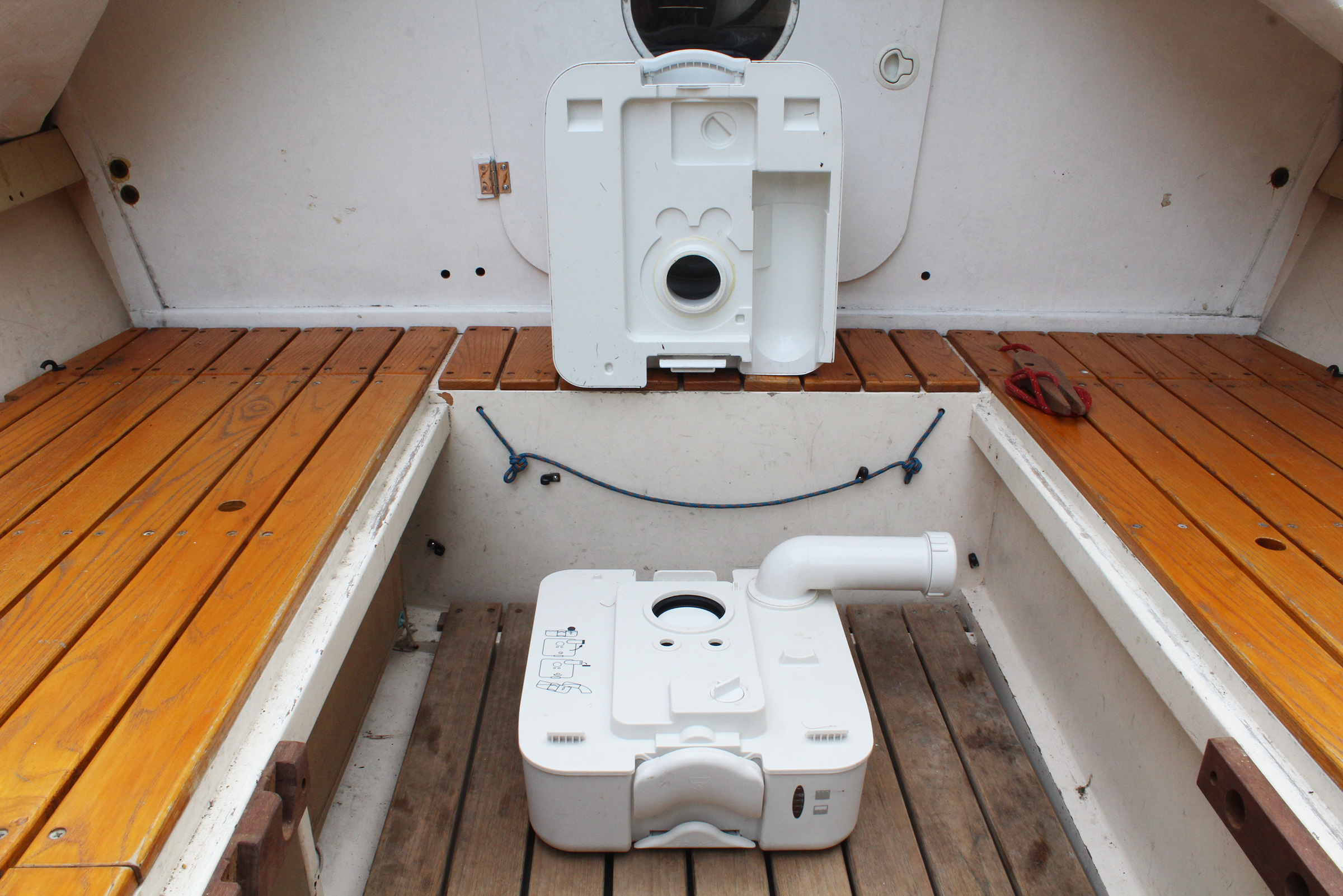
The holding tank has a a pivoting spout and a twist valve that remain open while pouring and to assure an even flow that’s less likely to splash.
At the back are a piston air pump to pressurize the tank for push-button flushing, and a threaded cap for the freshwater fill. The lower half houses the holding tank. A slide valve opens and closes the opening to the upper unit bowl and a clear insert in the front indicates the tank’s fill level.
A latch at the back holds the top and bottom together until it’s time to empty the holding tank. With the top removed, the tank is sealed by the slide valve and the capped pour spout. Both have rubber gaskets to make them airtight. The pour spout pivots to an angle convenient for emptying the tank into a plumbed toilet, and a small vent, when opened, assures a smooth, even flow.
The Thetford 135 is constructed in much the same way, and is 12-1/4″ tall, 13-1/2″ wide, and 15″ front to back. It weighs 8.9 lbs. The 2.6-gallon freshwater tank is rated for an average of 27 flushes, and a bellows-type water pump does the flushing. (The instructions indicate there is a piston pump option, but I can’t find it online.) The bottom half has a push-button air vent and a recess for storing a container of deodorizer.
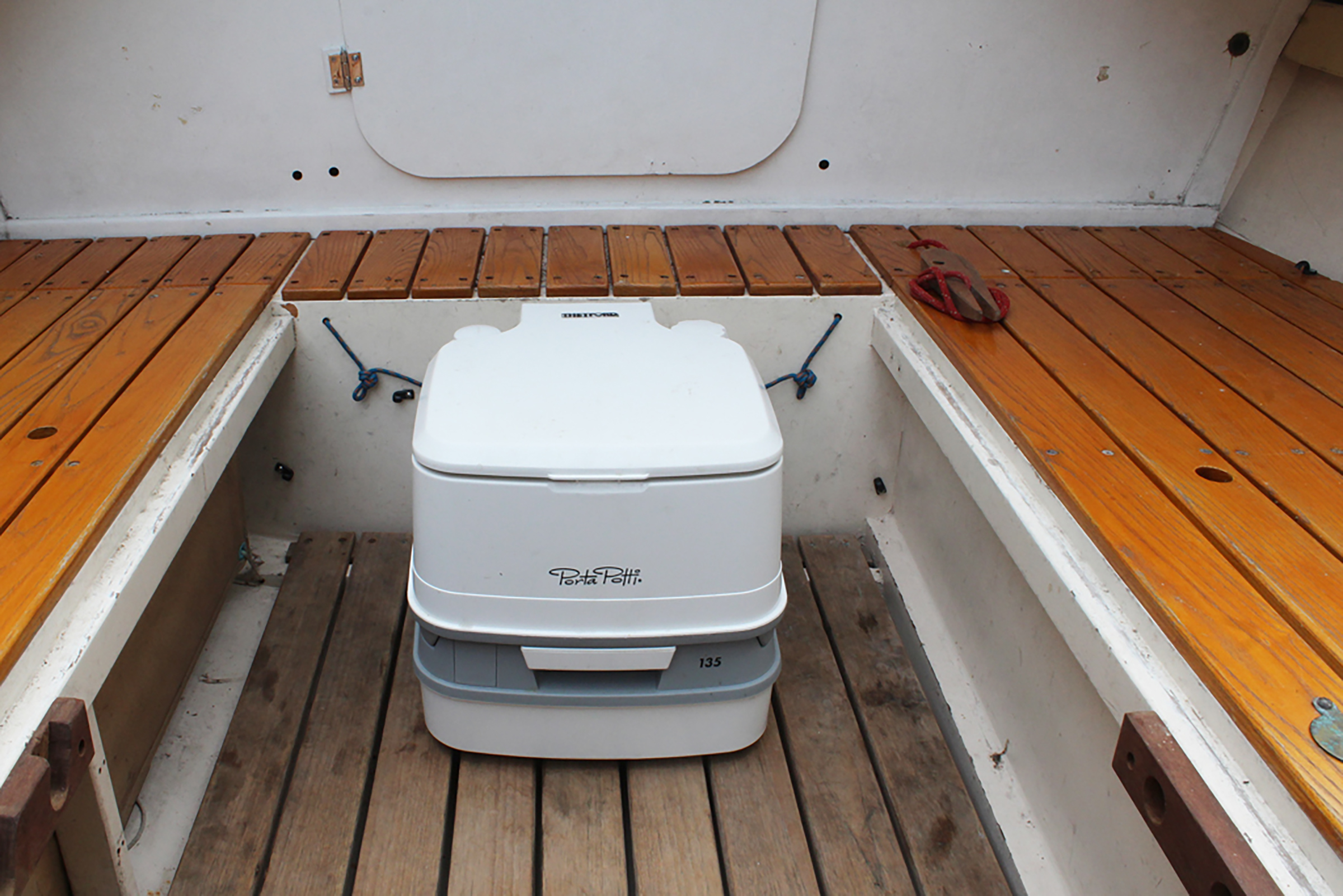
This Thetford 135 doesn’t have an indicator for the level of the holding tank.
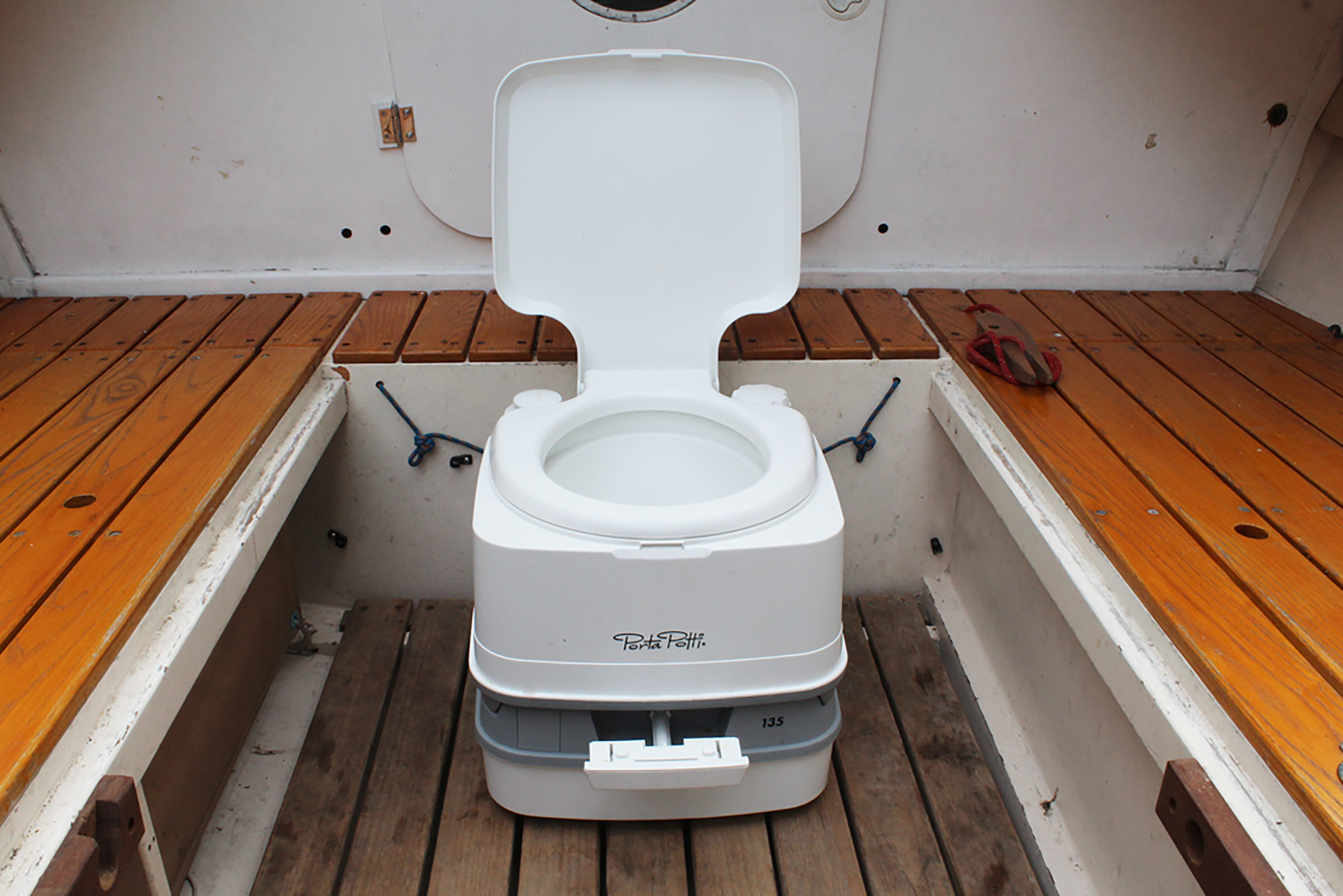
The Thetford, also made of ABS plastic, is slightly flexible and impact resistant. The glossy finish is easy to clean.
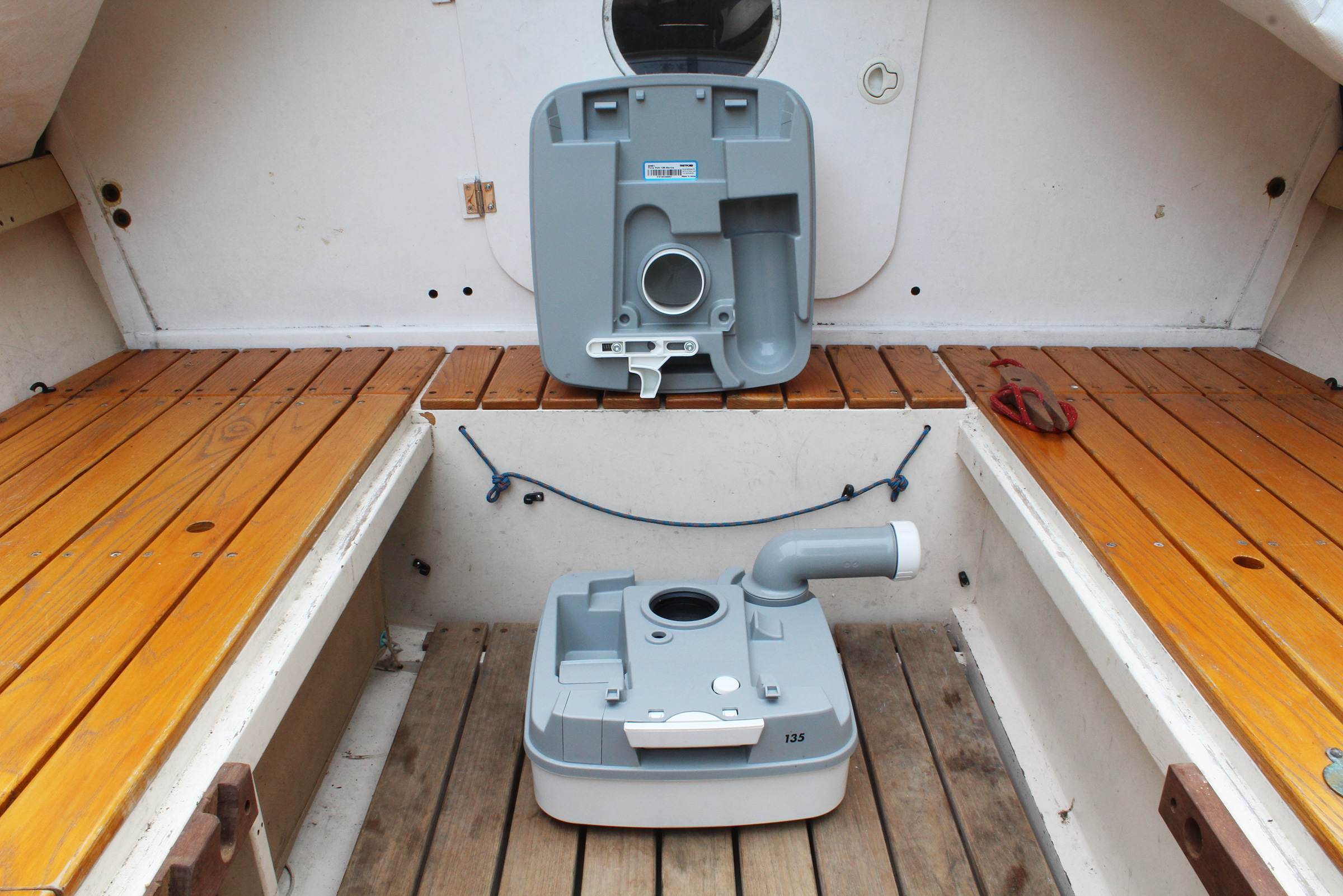
The Thetford’s air valve is a spring-loaded push button. With the right grip on the handle, you can hold the button down while pouring.
Both porta-potties have bracket kits for securing them to a floor to keep them from sliding around if the boat they’re used in heels or rocks. The lids and seats are removable for cleaning.
To prepare the toilets for use, I fill the freshwater tank and pour a liquid deodorizer and digester in the holding tank. It makes for an easier pour when I get back home from the outing.
Because I bought the smallest available porta-potties, compact enough to carry aboard my cruising boats, it was to be expected that they wouldn’t be as easy and comfortable to use as the toilets I have at home, which have higher and longer seats. The seat of my standard-bowl toilet is 15-1/2″ from the floor and the opening is 8-1/4″ wide and 10” long while the toilet I use most often has an elongated bowl with a seat 18″ high with a 12″ by 8-1/4″ opening. Although the porta-potties have seats with comparable opening widths of 8″, they are only 12″ high. I can elevate the porta-potties by rearranging floorboards, but the short opening of the seats takes some getting used to. The Dometic’s is 8-7/8″ long and the Thetford’s 9-3/8″, so a bit more concentration and attention is required by the user. I don’t do as much reading on the pot as I do at home, but I have done a bit of rowing.
I have used the Thetford on my recent cruise on Baker Lake and the Dometic on several solo three-day cruises and on a weekend cruise with four relying on it exclusively. I have always had capacity remaining in the holding tank of both porta-potties.
A neat trick I picked up off the web for leaving a porta-potti clean for the next user is to give the bowl a spritz of cooking oil from a pressurized can. Pam is a well-known brand; I use a house brand of organic extra-virgin olive oil. It comes in handy in the galley too.
Emptying the holding tank of either porta-potti is easy—just pivot the spout, uncap it, open the air vent, and pour the waste into a toilet at home. I follow up with a few rinses until the water I pour out runs clear. I can’t really say how well the deodorizer works—I always revert to a habit I picked up when I was changing my kids’ diapers and wear my workshop respirator with the charcoal filters for organic vapors.
I still make rest stops at parks, but more often I’m in undeveloped places where there are no facilities. There, my porta-potties make it much easier to leave no trace.![]()
Christopher Cunningham is the editor of Small Boats Magazine.
The Thetford 135 is sold through Amazon and Walmart for $84. The Dometic 972 is listed by the manufacturer at $101, and a 970-series is sold by Amazon for $120.
Is there a product that might be useful for boatbuilding, cruising, or shore-side camping that you’d like us to review? Please email your suggestions.
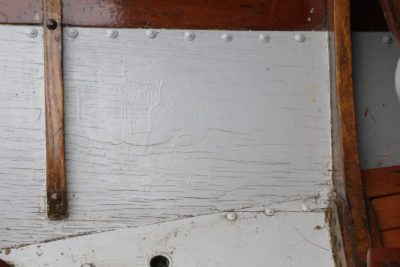
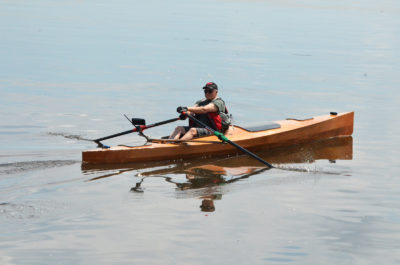
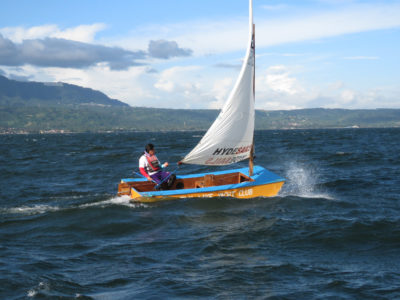

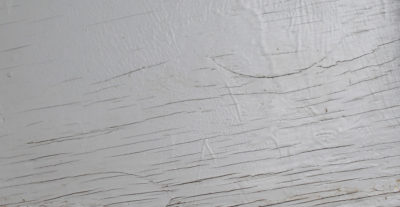
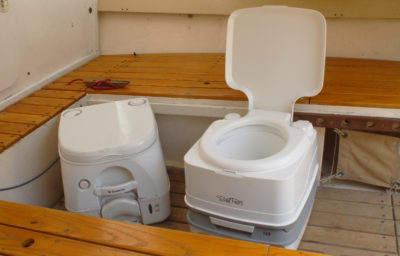
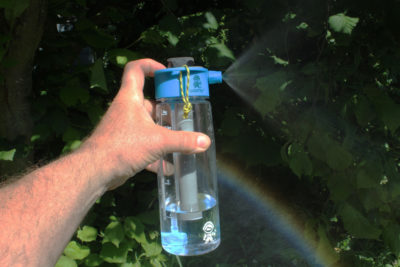
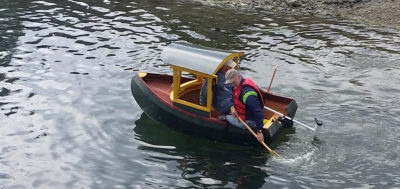
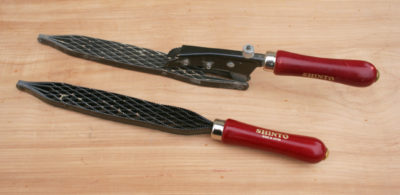
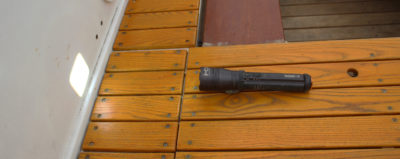
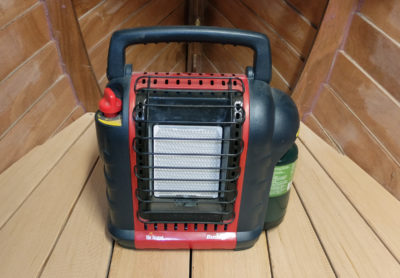
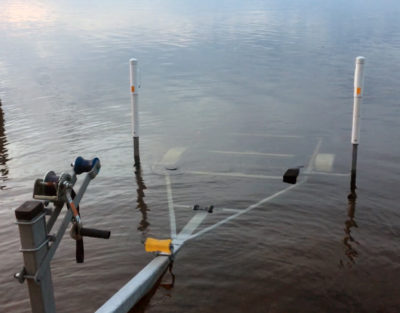
A timely article, Chris, as I have been contemplating the very same two units for my new boat.
Great review, thanks. Questions:
How much odor is emitted after a few uses? Is it noticeable in a confined space?
Any way to empty these at a pump out dock?
General question: is it environmentally harmful to dump urine overboard? I ask because on a river trip through the Grand Canyon, it was the “law” that all urinating done within 200 feet of the river had to go directly into the river; prior to this decree the hundreds of people going down the river each season were turning the narrow sand beaches, rock ledges, etc into foul-smelling urinals. If it’s okay for the Colorado River, is it okay for other inland and coastal waters?
The porta-potti holding tanks are airtight and I’ve never noticed any odor coming from them. With HESPERIA, if the weather is cold, I’ll use the porta-potti in the cabin next to the woodstove, but when it’s not in use, it is stowed in a closed compartment built into the port cockpit bench. Aboard the Caledonia Yawl, the porta-potti is sometimes in the canopy-covered sleeping quarters and in the Escargot canal boat it is kept in the cabin. In all three situations there have been no odors.
With a porta-potti available, that’s where I pee now. I used to just go over the side or in the Caledonia’s motor well, but I’ve given more thought to my leave-no-trace practices. It’s easy to think that one person wouldn’t cause much damage to the environment, but as you’ve remarked about the Grand Canyon, an accumulated effect can spoil a place. And if animals in the wild mark their territory with a bit of pee, I don’t think it’s right to stake any territory as mine. I’ve also been reading up on gray-water from dish washing, bathing, and brushing teeth, and decided that the porta-potti can play a role there too in keeping foreign materials out of the wilderness environment.
For years when on 4- to 7-day cruises, I used the 5-gallon -ucket method. I had a Thetford in storage cannibalized from a Capri 14 I used to own, but till recently, never thought to use it. First, I tried it for 5 days, at home. No odor. Easy to use. Then took it on its maiden voyage last summer on a 5 day trip in a 13′ microcruiser. Do I prefer it over the 5 gal. bucket? Absolutely. Not even close. Just wish I’d started using it sooner. I’d ordered a custom-made vinyl cover for it, so that when it’s on the cockpit floor and I’m in the cabin, I look out and see not “PortaPotti” but see square boxy thing with white vinyl cover over it, instead. Better aesthetics.
As I’ve aged, I’ve come to realize that the true mark of civilization is plumbing and how important it is first thing in the morning. I’ve been struggling with how to cope with the lack of plumbing aboard a cruising dinghy. I’ve realized that the problem is not where to store a porta-pottie, rather how to use it in an open boat. I’ll need to re-think the boat cover.
Farley Mowat, in Never Cry Wolf, was doing research on wolves and was camped near a den. His camp was practically on a well-used wolf track. Not knowing what to expect, he drank a lot of tea, then peed an arc around his camp spot. Later he watched a wolf approach, suddenly stop when he detected the pee zone, and thereafter the wolves always steered clear of his urine-scented barrier. Apparently the wolves interpreted this as “my territory; stay out.”
It should be pointed out that the city of Victoria BC dumped raw sewage into the Strait of Juan de Fuca until around 2020, when they finally built a sewage treatment plant. That seems a huge contrast with someone peeing overboard from a boat